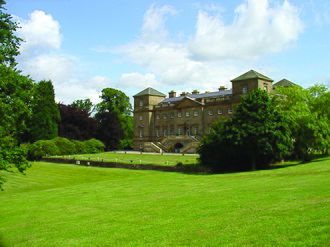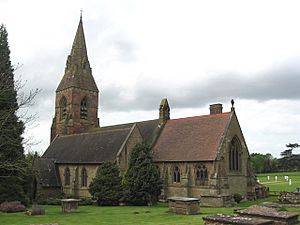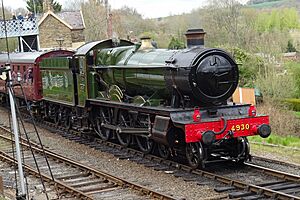Hagley Hall facts for kids
Quick facts for kids Hagley Hall |
|
|---|---|

Hagley Hall June 2011
|
|
| General information | |
| Architectural style | Neo-Palladian |
| Address | Hall Drive, Hagley, Worcestershire, DY9 9LG |
| Town or city | Hagley, Worcestershire |
| Country | England |
| Coordinates | 52°25′27″N 2°07′09″W / 52.4242°N 2.1191°W |
| Construction started | 1754 |
| Completed | 1760 |
| Client | George Lyttelton, 1st Baron Lyttelton |
| Design and construction | |
| Architect | Sanderson Miller |
Hagley Hall is a beautiful 18th-century house located in Hagley, Worcestershire, England. It is a very important historic building, given a special "Grade I" listing. This means it's considered to have exceptional interest.
Hagley Hall has been the home of the Lyttelton family for a long time. It was built by George, 1st Lord Lyttelton (1709–1773). He was an important person who worked for Frederick, Prince of Wales. He was also a poet and writer.
George Lyttelton started designing the gardens in a new, natural-looking style called Picturesque before 1751. Then, between 1754 and 1760, he built the main house. It was designed in the Neo-Palladian style, which was popular at the time.
In 1925, a big fire damaged the house. Most of it was fixed, but the top floor where the servants lived was not rebuilt. This means the roof looks a little different now than it did originally.
For many years, the estate faced financial problems. The family had to sell some land to keep the house going. Later, Christopher Charles Lyttelton, 12th Viscount Cobham began to restore both the house and its large park. Today, the park is open to visitors, and parts of the house can be rented for events.
As of 2025, Hagley Hall is still the family home of Christopher Charles Lyttelton, 12th Viscount Cobham and his wife, Tessa.
Contents
The House's Design and History
The Neo-Palladian style of architecture became popular in London around 1715. It slowly spread to other parts of England, reaching Worcestershire in the 1750s. Hagley Hall is one of the best examples of this style in the area.
Sanderson Miller designed Hagley Hall with help from John Sanderson. It was built between 1754 and 1760. The house has a simple outside look and special corner towers with pyramid-shaped roofs. It also features Venetian windows, which are large windows divided into three parts.
Inside, Hagley Hall has amazing Rococo plasterwork created by Francesco Vassali. It also holds a special collection of 18th-century furniture made by Thomas Chippendale. The house is also home to many family portraits by famous artists like Van Dyck and Joshua Reynolds.
The Great Fire of 1925
On Christmas Eve in 1925, a terrible fire swept through Hagley Hall. It destroyed much of the library and many valuable paintings. Even though melted lead was dripping from the roof, everyone inside managed to escape safely.
At the height of the fire, when nothing more could be saved, the 9th Viscount Cobham was very sad. He and his wife worked hard to restore the house. They rebuilt most of it, but they decided not to restore the staff quarters on the top floor.
Other Buildings at Hagley Hall
Just north of the main house, across a small road, is a large stable block. These buildings used to house horses and carriages. Now, the stable block is used as a business park for small local companies.
A short walk west of the Hall is the local church, St John the Baptist. Most members of the Lyttelton family have been buried in the churchyard since 1875. The churchyard also contains graves of other important families and their servants from the area. Next to the church is a cricket ground, home to Hagley Cricket Club, which has been around since 1834.
The Beautiful Grounds of Hagley Park
Hagley Hall is surrounded by a huge, beautiful park that covers about 350 acres (1.4 square kilometers). Herds of fallow deer graze peacefully in the park. The grounds were designed between 1739 and 1764.
The park features many interesting structures called follies. These are buildings that look like old ruins or temples, built just for decoration. Famous designers like John Pitt (of Encombe) and Sanderson Miller helped create them.
Notable Follies and Landmarks

One famous folly is the Hagley Obelisk, a tall, pointed monument built in 1764. You can see it from many miles away. Another is a copy of the Temple of Theseus, built between 1759 and 1762. This was a gift from Admiral Smith, George Lyttelton's half-brother. This temple needs some repair work and is on a list of historic places at risk.
The grounds of Hagley Park were very popular and attracted many famous visitors. Writers interested in landscape design, like Alexander Pope and William Shenstone, admired the park. Monuments were later built in the park to honor them.
Even Horace Walpole, who was hard to impress, loved Hagley Park after his visit in 1753. He wrote that he was amazed by its beauty. In 1786, John Adams, who later became the second President of the United States, visited Hagley with Thomas Jefferson. He wrote in his diary that Hagley was "superb."
After many years of not being cared for, restoration work has started in the park. The Hagley Obelisk was restored in 2010. More recently, the Palladian Bridge was rebuilt, and the view down the valley to the repaired Rotunda was cleared.
Hagley Hall and the Gunpowder Plot
Hagley Hall has a connection to the famous Gunpowder plot of 1605. This was a plan to blow up the Houses of Parliament. After the plot was discovered, two of the conspirators, Robert Wintour and Stephen Littleton, tried to hide.
They went to Hagley Park on January 9, 1606, to ask Humphrey Littleton for help. At that time, Meriel Littleton, whose husband had died in prison, lived at Hagley Park. However, Humphrey was using the house.
The authorities found out they were there because Littleton's cook, John Fynwood, told them. He was suspicious because of how much food was being eaten. Even though Littleton said he wasn't hiding anyone, a search was made. Another servant, David Bate, showed where the two plotters were trying to escape into the countryside. They were captured at Hagley Park.
Other Interesting Facts
The Great Western Railway built a series of steam locomotives named after famous halls. One of these, Locomotive 4930, was named Hagley Hall. This train is now preserved on the nearby Severn Valley Railway. In June 2007, on its way to be refurbished, the locomotive visited Hagley Hall itself and was parked right in front of the house!



